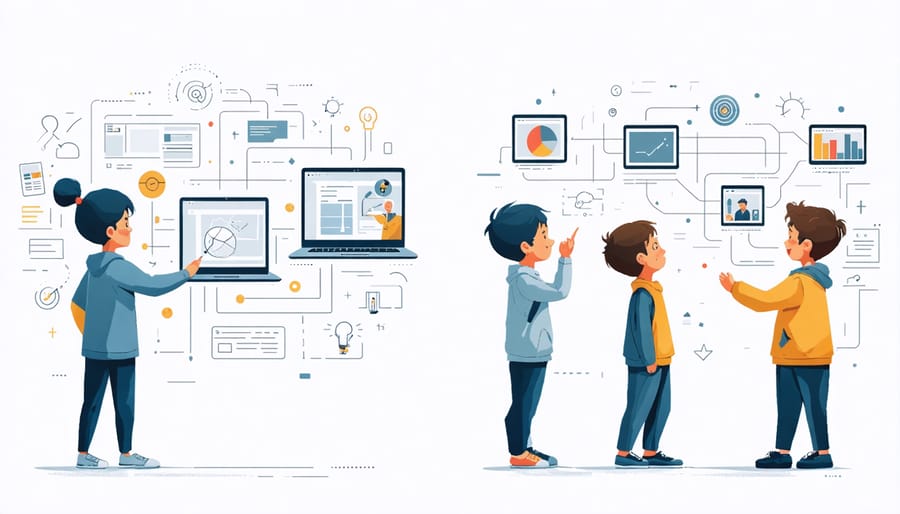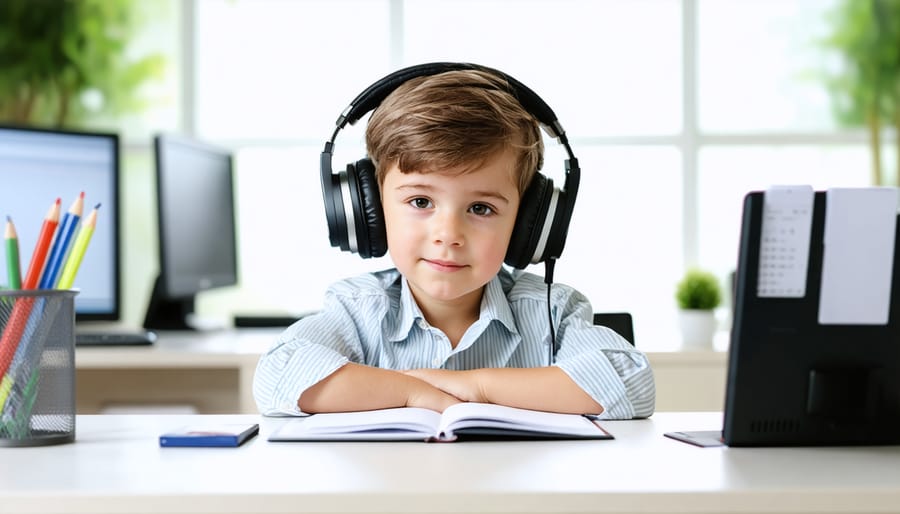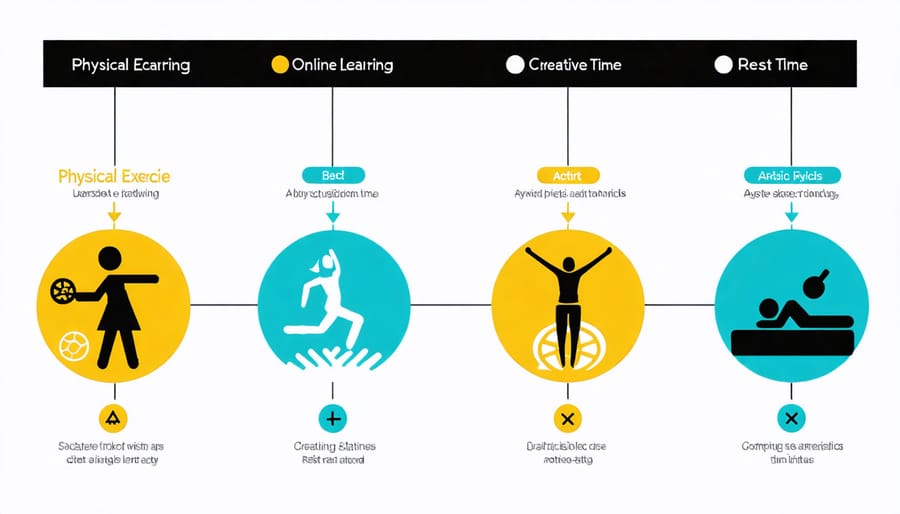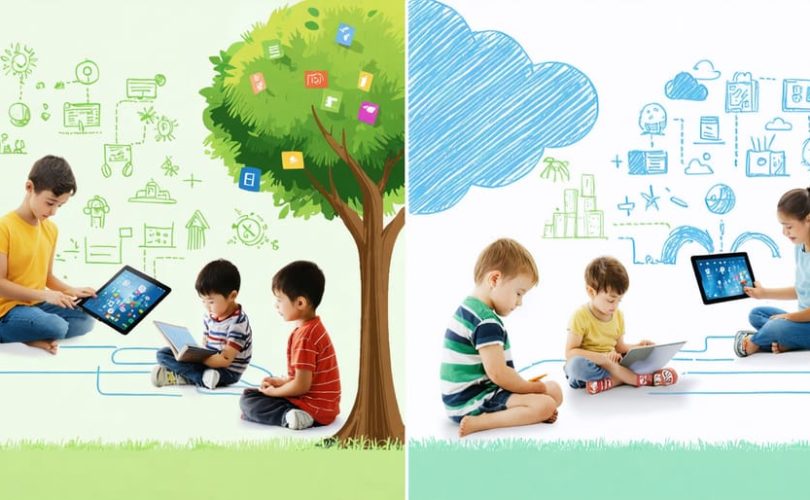In today’s digital age, understanding the complete picture of children’s well-being has never been more crucial. As screens become an increasingly integral part of learning and daily life, parents and educators face a complex challenge: nurturing children’s development across all dimensions of wellness while navigating the digital landscape.
The concept of well-being extends far beyond physical and mental health. Like a delicate ecosystem, true wellness emerges from the harmonious interaction of eight distinct dimensions: emotional, social, intellectual, physical, environmental, occupational, financial, and spiritual. Each dimension contributes uniquely to a child’s development and requires careful attention, especially in our technology-driven world.
Recent research shows that children spending more time in digital learning environments experience significant shifts across all wellness dimensions. Some changes bring unexpected benefits – like enhanced digital literacy and global connectivity – while others present new challenges requiring thoughtful solutions. By understanding these eight dimensions and their interplay with digital learning, we can better support our children’s journey toward holistic well-being.
This comprehensive guide explores each dimension through the lens of digital learning, offering practical strategies to help children thrive in our connected world while maintaining balance and healthy development across all aspects of their lives.
Emotional Well-Being in the Digital Classroom
Managing Screen-Time Emotions
Managing emotions during online activities can be challenging for children, but establishing healthy screen time habits can make a significant difference. Start by creating “emotion check-ins” throughout the day, encouraging children to identify and express their feelings about their digital experiences. When frustration arises, teach simple breathing exercises or suggest short movement breaks to reset their emotional state.
Parents and educators can help children develop emotional awareness by modeling positive responses to digital challenges. Create a safe space where children feel comfortable sharing their online experiences, whether positive or negative. Consider using mood tracking apps or emotion journals to help children recognize patterns in how screen time affects their feelings.
Remember that not all screen time is equal – collaborative online projects often boost positive emotions, while isolated browsing might lead to feelings of loneliness. Balance is key – aim for meaningful digital interactions while maintaining regular offline activities that nurture emotional well-being.

Social Connections in Virtual Spaces
Building Digital Social Skills
In today’s digital world, developing healthy online social skills is crucial for children’s well-being. Start by teaching kids to practice active listening even in virtual conversations, encouraging them to pay attention to others’ messages and respond thoughtfully. Help children understand digital empathy by discussing how their words and actions might affect others online, just as they do in person.
Guide children to maintain a balance between online and offline friendships, ensuring they don’t neglect face-to-face interactions. Teach them to recognize and respect online boundaries, including personal space in virtual environments and the importance of consent before sharing others’ information or photos.
Encourage positive online communication by modeling respectful dialogue and helping children express themselves clearly in digital spaces. Practice digital citizenship together by discussing appropriate online behavior, including how to respond to conflicts, support peers, and build meaningful connections while staying safe in virtual communities.
Remember that building digital social skills is an ongoing process that requires patience, guidance, and open communication between parents, educators, and children.
Physical Health and Digital Learning
As our children spend more time learning in digital environments, maintaining physical health becomes increasingly important. Creating an ergonomic learning environment is crucial for preventing posture-related issues and physical strain. Encourage children to sit with their feet flat on the floor, screens at eye level, and their backs properly supported.
Dr. Sarah Chen, a pediatric physiotherapist, recommends the “20-20-20 rule”: Every 20 minutes, take a 20-second break and look at something 20 feet away. This simple practice helps reduce eye strain and provides natural breaks for movement.
Balance is key when it comes to screen time and physical activity. Make movement a natural part of the digital learning routine by incorporating active breaks. These can be as simple as stretching exercises, jumping jacks, or a quick walk around the house. Many families have found success with “movement alarms” that remind children to get up and move every hour.
Remember to pay attention to warning signs of physical strain, such as headaches, neck pain, or blurred vision. These symptoms often indicate a need to adjust screen time habits or modify the learning setup. By being proactive about physical health during digital learning, we can help our children develop healthy habits that will serve them well throughout their lives.

Intellectual Growth Through Technology
In today’s digital age, technology has become an invaluable tool for intellectual growth and cognitive development. Research shows that thoughtfully implemented educational technology benefits can enhance learning experiences in remarkable ways. Children and adults alike can leverage digital resources to explore new subjects, develop critical thinking skills, and engage with information in interactive formats that suit their unique learning styles.
Digital tools like educational apps, online courses, and virtual reality experiences offer personalized learning paths that adapt to individual needs and pace. For example, language learning apps use spaced repetition and adaptive algorithms to help retain information more effectively, while creative coding platforms introduce complex concepts through engaging, game-like experiences.
However, it’s essential to maintain a balanced approach. Setting healthy boundaries around screen time and combining digital learning with hands-on experiences creates the most effective learning environment. Parents and educators can guide this process by:
– Choosing age-appropriate educational content
– Encouraging active rather than passive technology use
– Using digital tools to supplement, not replace, traditional learning methods
– Creating opportunities for collaborative online learning
– Monitoring progress and adjusting digital learning strategies as needed
Remember that intellectual growth through technology isn’t just about consuming content—it’s about creating, connecting, and developing the skills needed to thrive in our increasingly digital world.
Environmental Wellness in the Digital Age
Creating a harmonious environment for digital learning starts at home, where both physical and virtual spaces impact your child’s well-being. Begin by establishing a dedicated learning area that’s well-lit, comfortable, and free from distractions. This space should promote good posture and reduce eye strain, with appropriate screen height and regular breaks for movement.
In the digital realm, maintaining a healthy environment means implementing online safety best practices and creating boundaries between study and leisure time. Consider using blue light filters on devices and maintaining consistent screen-time schedules that allow for both focused learning and digital detox periods.
Environmental wellness also extends to the organization of digital resources. Help your child create structured folders for assignments, establish bookmarking systems for educational websites, and maintain a clutter-free desktop. This digital organization mirrors the importance of physical organization and helps reduce stress and anxiety.
Remember to balance indoor screen time with outdoor activities. Encourage regular breaks that involve nature connection, physical movement, or simply changing scenery. This combination of thoughtful digital space management and connection with the natural environment helps children develop a healthy relationship with technology while maintaining their overall well-being.
Financial Understanding and Digital Resources
In today’s digital world, helping children develop a healthy relationship with technology and financial resources is crucial for their overall well-being. Teaching kids about online safety starts with open conversations about responsible internet use, including privacy settings, sharing personal information, and recognizing potential online risks.
Parents and educators can create opportunities for children to learn about financial literacy through age-appropriate digital tools and apps designed for money management. This might include virtual piggy banks, educational games about saving and spending, or family discussions about online purchases and digital transactions.
It’s equally important to establish balanced screen time guidelines while acknowledging the educational benefits of digital resources. Consider implementing a family media plan that includes designated tech-free times and spaces, encouraging children to maintain a healthy balance between online and offline activities.
Remember to model good digital habits yourself, as children often learn by example. This includes demonstrating responsible social media use, protecting personal information online, and making thoughtful decisions about digital purchases. By fostering these skills early, we help children develop into financially savvy and digitally responsible individuals.
Occupational Balance
In today’s digital age, helping children find the right balance between screen time and other activities is crucial for their well-being. Parents can start by creating a structured daily schedule that allocates specific times for online learning, physical activities, and leisure. Consider using visual timetables for younger children, making it easier for them to understand and follow their daily routines.
Encourage regular breaks during digital schoolwork using the 20-20-20 rule: every 20 minutes, take a 20-second break and look at something 20 feet away. This helps reduce eye strain and maintains focus. Mix educational screen time with hands-on learning activities, such as craft projects, outdoor exploration, or simple science experiments.
Set clear boundaries between school and free time by designating specific areas for studying and playing. When homework is done, guide children toward engaging offline activities like reading physical books, playing board games, or pursuing creative hobbies. Remember that quality screen time is more important than quantity – choose educational apps and content that truly benefit your child’s development while maintaining a healthy balance with real-world experiences.

Spiritual and Personal Growth
In today’s digital landscape, nurturing a child’s spiritual and personal growth requires thoughtful consideration of how technology intersects with identity development. Children need opportunities to explore their values, beliefs, and sense of purpose, even as they navigate digital spaces.
Parents and educators can encourage meaningful self-reflection by creating digital-free zones where children can practice mindfulness, journaling, or quiet contemplation. These moments of disconnection allow young minds to process their experiences and develop a stronger sense of self.
Consider implementing “values discussions” during family time, where children can share their thoughts about online experiences and how they align with personal beliefs. This helps them develop critical thinking skills and maintain authenticity in both digital and real-world interactions.
Expert child psychologist Dr. Sarah Chen notes, “When children understand their core values, they’re better equipped to make conscious choices about their digital engagement. They’re more likely to seek out content and connections that truly resonate with who they are.”
Encourage activities that foster personal growth, such as digital creativity projects that express individual interests or online volunteering opportunities that align with their values. Remember that spiritual and personal development looks different for each child, so maintain an open, supportive approach to their journey of self-discovery.
Supporting your child’s well-being across all eight dimensions requires consistent attention, open communication, and a willingness to adapt to their changing needs. Remember that each child’s journey is unique, and what works for one may not work for another. By staying involved in your child’s digital learning experience while maintaining a balanced approach to all aspects of their well-being, you can help them thrive in today’s increasingly connected world.
Take small steps to implement the strategies we’ve discussed, whether it’s setting aside dedicated time for physical activity, creating quiet spaces for emotional reflection, or fostering meaningful social connections both online and offline. Pay attention to how your child responds to different approaches and be prepared to adjust your strategy accordingly.
Most importantly, don’t hesitate to reach out for support when needed. Connect with teachers, counselors, and other parents who are navigating similar challenges. By working together and staying informed about your child’s well-being across all dimensions, you can help create a strong foundation for their healthy development and future success.
Remember, you’re not just supporting their academic growth – you’re helping shape a well-rounded individual who can navigate life’s challenges with confidence and resilience.

